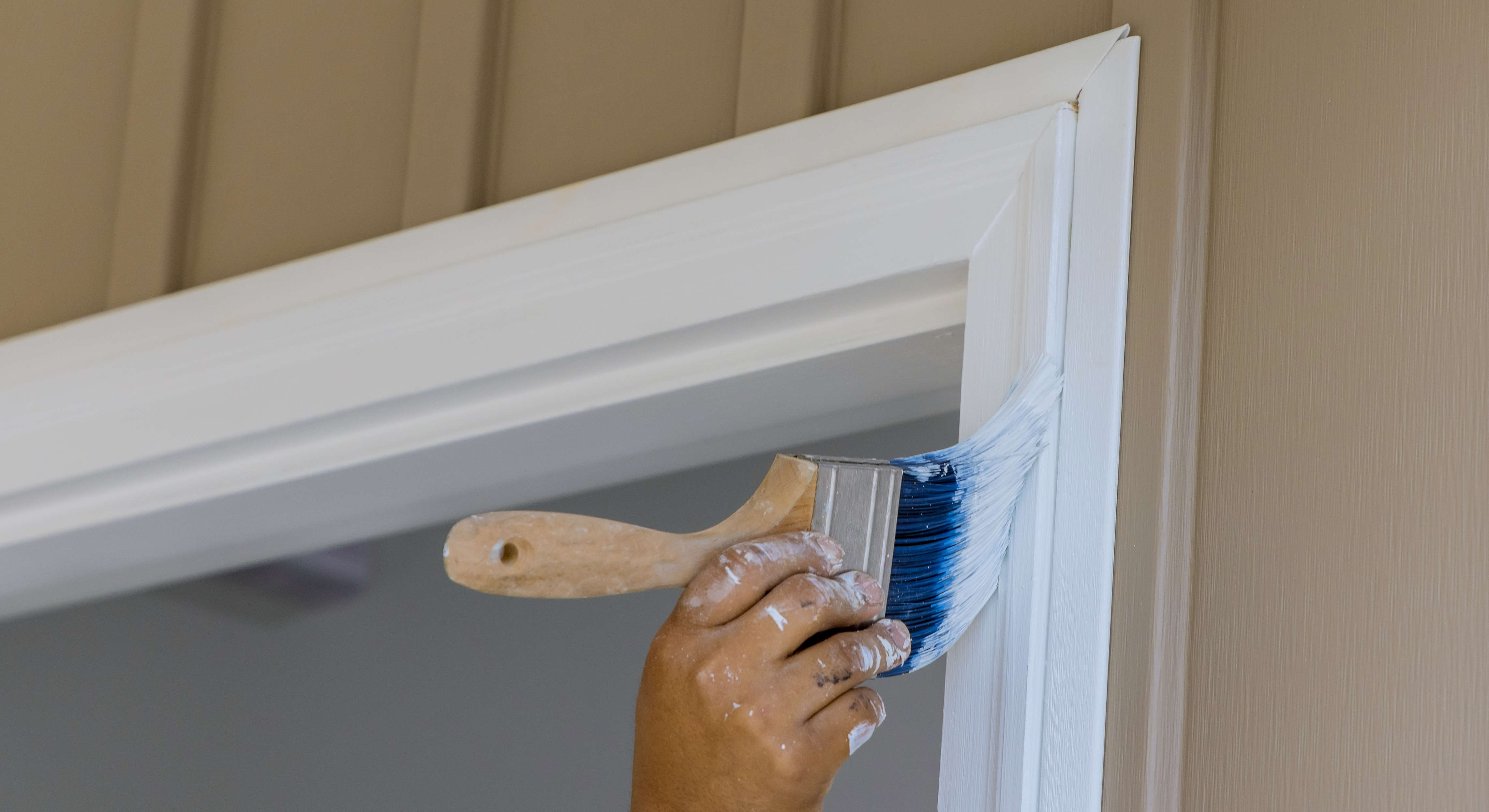How to choose the best paint for your interior finish — from durability to sheen
Get the perfect paint finish for your interior project

Every room in a house faces different challenges. While the hallway is a busy thoroughfare, the kitchen and bathroom battle heat and moisture daily, while bedrooms are the quietest of all. So, when decorating each room, they all have their own needs in terms of paint choice.
Some rooms will require tough, durable paint that’s easy to clean and will stand what everyday life throws at it, while other spaces will be more restful and will cope with paints and finishes that rarely need wiping down or retouching.
Here, we present a lowdown on the range of interior paints, the choice of finishes and the best option for your decorating projects.
Your paint choice depends on the surface
Paint is primarily divided into the surfaces it covers. In our homes, this covers wood — baseboards, window frames and trim — and walls and ceilings. Your paint choice will also depend on how durable it needs to be and whether it's likely to need cleaning. Then, there's the issue of choosing between an oil-based and water-based paint and knowing the qualities of each.
Oil-based paints

Oil-based paints are split into two types — alkyd and enamel paint. They are both hard-wearing and suitable to use in high-traffic areas. However, oil-based paints have a slow drying time, and you’ll need to use a paint thinner to clean up your brushes.
Alkyd paint
As its name suggests, alkyd paint contains alkyd oil as its base product. It adheres to wood and is a good choice in high-impact areas, such as hallway floors, for painting baseboards, trim and furniture. It’s more suitable for interior projects than enamel paint.
Enamel paint
Enamel is another long-lasting and durable paint which is more likely to be used outside. However, it can be used to paint internal doors, giving a high-gloss finish. While it was traditionally oil-based, there are more water-based options available.
Water-based paints

Water-based paints use water as the main liquid solvent. They are sometimes called acrylic, latex or acrylic latex paint, and are more flexible than oil-based products. Plus, they have a faster drying time and are easier to clean using soap and water.
Latex paint
This is the most popular choice for interior paint and is also the most environmentally friendly. However, it’s not as hard-wearing as oil-based paint and is more suitable for walls and ceilings that don’t get kicked and scuffed as much as baseboards.
Acrylic paint
Although very similar to latex paint, 100% acrylic paint is also water-based, although the difference is that it contains more acrylic polymers, making it more durable and pricey. As it’s more durable than latex paint, it’s more suitable for painting furniture, and can be used to update your kitchen cabinets.
Sign up to get the BEST of Tom's Guide direct to your inbox.
Get instant access to breaking news, the hottest reviews, great deals and helpful tips.
Changes to oil-based paint
In recent years, there has been a change to the composition of oil-based paint and a move towards using water-based alternatives. So, why the change? Oil-based paint is an alkyd, and tends to turn yellow over time. To slow down the “yellowing” process, manufacturers added chemicals, known as volatile organic compounds (VOCs), into the mix. However, these chemicals are now understood to be detrimental to our health and the environment, as they evaporate and cause air pollution. So, to limit the amount of VOCs added to paints and varnishes, the EU implemented the Paints Directive.
Do the same rules apply in the U.S.?
We asked Dennis Fiorilli, director of product excellence at Sherwin-Williams, if the same restrictions apply in the U.S.: “The trend in the U.S. is very similar to that of the U.K. With VOC rules changing in many states, painters have had to adjust to different products used on trim.”
New technology
Innovations in paint technology have made it possible to create water-based alternatives. Fiorilli says Sherwin-Williams’ ProClassic Waterborne Interior Latex Enamel (from $34, Sherwin-Williams) is a great water-based option for trim. Like many other paint manufacturers, the company has developed hybrid technology that meets VOC rules. It now provides products with the feel and durability of an oil-based paint, but with the advantage of a soap and water clean-up. Fiorilli gives the brand’s Emerald Urethane Trim Enamel (from $45, Sherwin-Williams) as an example of the hybrid technology.
There’s one benefit that immediately comes to mind. Clearing up brushes after using traditional oil-based paint was a chore — it just got everywhere. In comparison, cleaning brushes and paint trays with soap and water is a breeze.
The risks associated with using VOCs are outlined by the U.S. Environmental Protection Agency.
Paint for wood: primer, undercoat and top coat

Untreated wood will soak up paint fast, so it needs to be treated first with a primer — this acts as a foundation layer and helps to seal the wood in readiness for further painting. But before applying the primer, give the wood a light sand.
If the surface of the wood is already painted, use an undercoat. Its job is to provide a smooth and level base for the topcoats. The top coat forms the final layer, or layers, which give a decorative and protective finish.
Tip
Always check the paint’s application details and drying times before applying.
Types of paint finish
Once you’ve decided whether your project requires either an oil-based or water-based paint, the next option is choose the finish. This can dramatically affect the final look, so you’ll want to get it right to save a repaint job.
Flat finish
Whenever I hear the paint term “flat”, I think of the word “deadpan”. Although it's not a cheery turn of phrase, it sums up the appearance of this paint finish. Flat paint is non-reflective, without a sheen, which to me means it doesn't project a glowing smile. However, that’s no bad thing when painting less than perfect surfaces.
Flat paint soaks up rather than reflects the light and is a good choice in houses with bumpy walls as it helps to hide imperfections. It also has a chalky finish that can give it a velvety appearance, which looks great on walls and cabinets.
However, if you need to wipe down your walls, cleaning can be tricky without removing some of the paint. Therefore, it’s best avoided in kids’ rooms, unless you’ve got a household of little angels.
Tip
If painting a wall with defects, the higher the sheen, the more the imperfections will show.
Matt finish
According to Sherwin-Williams, it’s seen a rise in the popularity of paint with a matt finish. Fiorilli says: “A matt is between a flat and satin finish. The slight sheen helps hide imperfections, but still allows for some washability.”
It could be the convenience of being able to wipe down a paint that’s so attractive. Matt paints also tend to have more pigment than flat paints, giving them a richer colour.
Eggshell finish

Eggshell is one of the most popular paint finishes according to Fiorilli and holds the top spot with satin. On the sheen scale it sits between a satin and a flat finish — just like a hen’s egg, it looks flat but has a slight gloss. Without a high sheen that’s light reflective, eggshell is good at covering imperfections.
Eggshell is a good allrounder and is suitable to use in areas where a medium level of durability is needed, making it ideal for dining and living rooms, bedrooms and hallways. It’s also easy to clean.
I used an eggshell paint to upcycle a table when I revamped my guest bedroom (see the image above).
Satin finish
Satin is a hard-wearing paint with a soft sheen that’s ideal throughout the house on walls and woodwork. It provides a durable finish without the high sheen of a gloss and is a good choice for kitchen cabinets, stairways and other interior woodwork, such as wall paneling. And as it’s resistant to mildew, it’s also suitable in bathrooms where condensation can be an issue.
With a tough finish, it can be cleaned easily, although retouching can be a slight issue as the higher the sheen value of the paint, the easier it is to see blemishes.
Semi-gloss finish
This gloss paint sits one further up the sheen scale than its neighbour, satin. It’s more reflective and copes well in high-moisture areas, such as bathrooms and kitchens, where moisture and grease can be an issue. Semi-gloss is also a good choice for trims and woodwork in high-traffic areas that see constant wear and tear, but when you don’t want the ultra sheen that a high gloss provides.
On the cleaning front, it’s super easy to wipe over, and its durability keeps it looking smart for longer.
High-gloss finish

This is the king of durability regarding paint finishes. It’s hard-wearing, light-reflective and the easiest of the bunch to clean. So, if you need paint that will withstand every challenge your household throws at it, this is the one for you. Although I wouldn’t advise putting it on your walls, keep it to the woodwork, unless you hire a professional. You might find it helpful to learn a few tricks before painting a room.
It can be notoriously challenging to work with, and its high sheen qualities will show every lump, bump and paint drip in your walls and woodwork. And once dry it will illuminate every fingerprint. So, although it’s suitable for trims, baseboards, doors, window frames and kitchen cabinets, and has light-reflecting qualities that can brighten up a room, if you don’t want to be cleaning fingerprints off your kitchen cabinets, swap to a semi-gloss or satin finish.
More from Tom's Guide
- New to interior painting? Learn how to paint a room
- Discover 7 painting mistakes to avoid when decorating
- Plus, How to get paint out of a carpet

Camilla Sharman has worked in publishing and marketing for over 30 years and has covered a wide range of sectors within the business and consumer industries both as a feature, content, and freelance writer.
As a business journalist, Camilla has researched articles for many different sectors from the jewellery industry to finance and tech, charities, and the arts. Whatever she’s covered, she enjoys delving deep and learning the ins and out of different topics, then conveying her research within engaging content that informs the reader. In her spare time, when she’s not in her kitchen experimenting with a new recipe, you’ll find her keeping fit at the gym. In the pool, stretching at a yoga class, or on a spin bike, exercise is her escape time. She also loves the great outdoors and if she’s not pottering about in her garden, she’ll be jumping on her bike for a gentle cycle ride.
